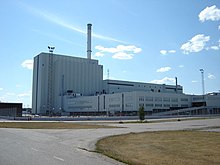Forsmark Nuclear Power Plant
| Forsmark Nuclear Power Plant | |
|---|---|

Reactor 3 at Forsmark Nuclear Power Plant.
|
|
| Country | Sweden |
| Location | Forsmark |
| Coordinates | 60°24′12″N 18°10′0″E / 60.40333°N 18.16667°ECoordinates: 60°24′12″N 18°10′0″E / 60.40333°N 18.16667°E |
| Status | Operational |
| Commission date | 1980 |
| Operator(s) | Vattenfall |
| Nuclear power station | |
| Reactor type | BWR |
| Cooling source | Bothnian Sea |
| Cooling towers | no |
| Power generation | |
| Units operational | 2 x 1010 MW 1 x 1190 MW |
| Capacity factor | 79.3% |
| Annual gross output | 22,300 GWh |
|
Website www |
|
Forsmark Nuclear Power Plant is a nuclear power plant in Forsmark, Sweden, and also the site of the Swedish Final repository for radioactive operational waste. It is operated by a subsidiary of Vattenfall.
The radiation monitors at Forsmark were the first outside the Soviet Union to detect the elevated radiation levels resulting from the Chernobyl disaster, over 1,000 km away, forcing the Soviet government to publicly acknowledge it after almost a day of hiding it from the world.
Forsmark NPP has three Boiling water reactors:
West of Forsmark Nuclear Power Plant, there is the static inverter of HVDC Fenno-Skan.
Forsmark is the proposed site for the long-term burial of all spent fuel from Swedish nuclear power reactors, using the KBS-3 process. The new site will be located next to the already existing final repository for radioactive operational waste, but the two will not be connected with each other.
On 25 July 2006, one reactor was shut down after an electrical fault. According to the Swedish Nuclear Power Inspection authority SKI, the incident was rated 2 on the International Nuclear Event Scale. Initially it was rated 1 since two generators remained online. But once it was discovered that all four generators could have failed due to the same fault, the event was upgraded to 2.
The first proximal cause of the accident was maintenance work in the adjacent high-voltage yard by the Swedish grid operator Svenska Kraftnät. An incorrect interlock procedure caused a disconnector to open which sustained an arc that caused a two-phase short circuit in equipment directly adjacent to the plant. This short caused the station generators to disconnect from the grid and, due to the failure of further safety systems this disconnection, in turn, led to a large overvoltage on various supplies within the station. The overvoltage caused failure of the control circuitry of two of the four redundant UPS systems which supplied the safety critical equipment at the plant, including cooling pumps and control circuitry. Though diesel generators started correctly even on these two systems, the lack of control circuitry led to them being unable to engage with their corresponding circuits. The other two UPS systems functioned correctly, surviving the overvoltage, probably due to an undetermined subtle difference in wiring or equipment between the two pairs of units. The reactor fully and effectively scrammed immediately on detecting these supply failures, however staff relied on neutron detector readings to determine reactor state due to lack of information on control rod state. At all times effective cooling was maintained by the pumps operating on the two functioning circuits. Though a number of options remained to operators had further equipment failed, a single cause (one short-circuit) leading to such a cascade of failures was seen as a challenge to the principle of redundancy and safety in depth.
...
Wikipedia
